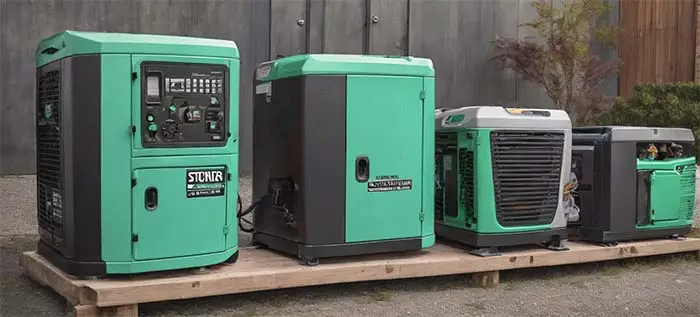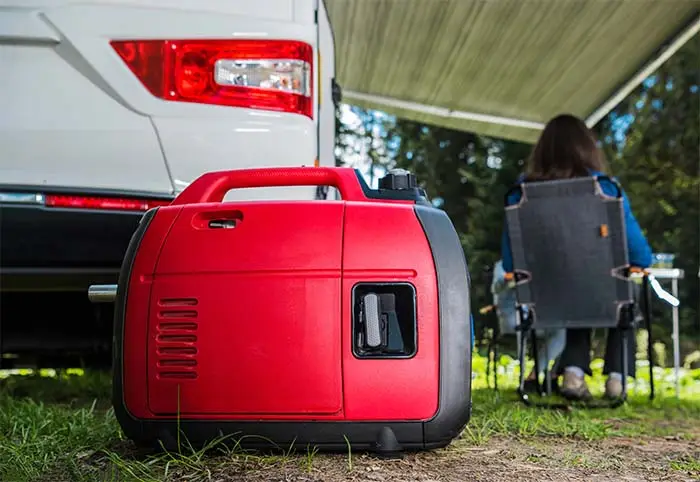Introduction
How To Avoid Common Mistakes When Using A Portable Generator
In order to make the most out of your portable generator and ensure a seamless experience, it is important to be aware of common mistakes that can be easily avoided.
This article will provide you with valuable tips and insights on how to use a portable generator effectively, avoiding potential mishaps that could occur. By implementing these simple strategies, you can ensure the safe and efficient use of your portable generator, allowing you to power your devices and appliances with confidence.
So, let’s explore the key mistakes to steer clear of when utilizing a portable generator.
Choosing the Right Generator
Consider Your Power Needs
When choosing a generator, it is essential to consider your power needs. Start by making a list of the appliances and devices you will need to power during an outage or in a remote location.
Consider the wattage requirements of each item and add them up to determine the total power capacity you will need for your generator. This will help you choose a generator that can handle the load and ensure that you have enough power to meet your needs.
Determine the Fuel Type
Generators can use a variety of fuel types, such as gasoline, diesel, propane, or natural gas. Each fuel type has its pros and cons, so it’s important to consider factors such as availability, cost, and safety when making your decision.
Gasoline is the most common and readily available fuel, but it can be volatile and has a shorter shelf life. Diesel is a more stable fuel option but may be less readily available.
Propane and natural gas are cleaner-burning fuels and tend to have longer shelf lives, but they may require additional equipment or installation.
Evaluate Noise Levels
Generators can be noisy, especially if they are running for extended periods. This can be a concern, particularly if you live in a residential area or need to use the generator for camping or other outdoor activities.
When choosing a generator, consider the noise levels specified by the manufacturer. Look for generators that have noise reduction features, such as insulation or a muffler, to minimize the disturbance.
Additionally, you can also place the generator farther away from occupied areas or use noise-blocking barriers to further reduce the noise impact.

Proper Generator Placement
Identify a Well Ventilated Area
Proper generator placement is crucial for safe and efficient operation. Generators produce exhaust fumes that contain carbon monoxide, a highly toxic gas.
To prevent carbon monoxide buildup, it is essential to place the generator in a well-ventilated area, preferably outdoors.
Avoid running the generator in enclosed spaces like garages or basements, as this can lead to a dangerous buildup of carbon monoxide. Always ensure that there is enough space around the generator for proper airflow.
Maintain Proper Distance from Combustible Materials
Generators produce heat and can pose a fire risk if placed too close to combustible materials. When choosing a location for your generator, make sure to keep it at least five feet away from any flammable items, such as buildings, fences, or trees.
This will help minimize the risk of accidental fires. Additionally, be cautious of the generator’s exhaust, which can become hot during operation. Avoid placing the generator near any materials that could melt or ignite due to high temperatures.
Avoid Exposure to Moisture
Moisture can damage the electrical components of a generator and pose safety hazards. Always keep the generator dry and protected from rain, snow, or other sources of moisture.
If you need to use the generator during inclement weather, consider using a generator tent or cover specifically designed to provide protection. This will help prevent water from entering the generator and potentially causing electrical shorts or other malfunctions.
Ensuring Safe Operation
Read and Understand the User Manual
Before operating a generator, thoroughly read and understand the user manual provided by the manufacturer. The manual contains essential instructions regarding setup, operation, maintenance, and safety guidelines specific to your generator model.
Familiarize yourself with the various controls, safety features, and recommended operating procedures described in the manual. This will ensure that you use the generator safely and maximize its performance.
Inspect the Generator Before Each Use
Regular inspection of the generator is crucial to identify any potential issues or damage before operating it. Before each use, visually inspect the generator for any signs of wear, loose parts, or leaks.
Check the fuel and oil levels and ensure that all electrical connections are secure. If you notice any abnormalities or concerns, consult the user manual or contact a qualified technician for further inspection or repairs.
By performing these inspections regularly, you can catch any problems early and prevent more significant issues from arising.
Use Proper Extension Cords
When connecting appliances or devices to your generator, always use proper extension cords. It is important to use cords that are rated for outdoor use and have the appropriate gauge for the power load.
A larger gauge (lower number) is needed for higher power loads to prevent overheating and voltage drops. Additionally, make sure that the extension cords are in good condition, with no frayed wires or damaged plugs.
Properly connecting and securing the cords will help reduce the risk of electrocution and ensure a stable power supply.
Understanding Load Capacity
Calculate your Power Requirements
To avoid overloading your generator, it is crucial to calculate your power requirements accurately. Start by identifying the wattage of each appliance or device you plan to power.
This information is typically listed on the product label or in the user manual. Add up the wattage of all the items you will be using simultaneously to determine the total power requirement.
It is essential to choose a generator with a capacity that exceeds your calculated power requirement to ensure safe and reliable operation.
Avoid Overloading the Generator
Overloading a generator can lead to equipment damage, decreased performance, or even a complete shutdown. Always check the generator’s rated capacity and compare it to the total power requirement of the appliances and devices you plan to power.
If the total power requirement exceeds the generator’s rated capacity, prioritize the essential items and distribute the load accordingly.
Avoid connecting high-power appliances simultaneously, as this can overload the generator and lead to malfunctions or failure.
Balance the Load Distribution
Properly distributing the load among the available power outlets on your generator is crucial for efficient and safe operation.
Avoid connecting all the appliances to a single outlet or overloading one outlet while others remain unused. Instead, distribute the load evenly across the available outlets, taking into account the wattage requirements of each device.
By balancing the load distribution, you will maximize the generator’s performance, prevent overheating, and prolong its lifespan.

Fuel Management
Use Fresh and Stable Fuel
Using fresh and stable fuel is essential for the optimal performance and longevity of your generator. Avoid using old or stale fuel, as it can lead to starting issues, poor engine performance, and potential damage.
It is recommended to use fresh fuel that has been stored for no longer than 30 days. Additionally, consider using fuel stabilizers to extend the shelf life of the fuel and prevent varnish or gum buildup in the generator’s fuel system.
Store Fuel Safely
Proper fuel storage is crucial for both the safety and the reliability of your generator. Always store fuel in approved containers that are specifically designed for fuel storage.
These containers should be kept in a cool, well-ventilated area away from any ignition sources or direct sunlight. It is important to follow local regulations and guidelines regarding the amount of fuel you can store and any restrictions on fuel storage in residential areas. Regularly check the fuel containers for any signs of leaks or damage.
Monitor Fuel Levels
Regularly monitoring fuel levels is essential to ensure uninterrupted power supply and prevent sudden shutdowns. Many generators come equipped with fuel gauges or indicators that display the current fuel level.
Familiarize yourself with the fuel gauge or indicator on your generator and monitor it regularly during operation.
It is recommended to have a backup fuel supply available, especially during extended power outages or when using the generator in remote areas where fuel availability may be limited.
Maintenance and Repairs
Perform Regular Maintenance
Regular maintenance is crucial to keep your generator in optimal condition and ensure safe and reliable operation.
Follow the maintenance schedule outlined in the user manual provided by the manufacturer. This may include tasks such as changing the oil, replacing filters, inspecting and tightening connections, checking and adjusting spark plugs, and cleaning the generator’s exterior.
By performing regular maintenance tasks, you can detect and address any potential issues before they escalate and maximize the lifespan of your generator.
Clean the Generator Properly
Proper cleaning of your generator is important to prevent dirt, dust, or debris from interfering with its performance. Before cleaning, ensure that the generator is turned off and has cooled down.
Use a damp cloth or soft brush to remove any dirt or grime from the exterior surfaces. Avoid using harsh chemicals or abrasive materials that could damage the generator’s finish.
Additionally, clean the air filters regularly as per the manufacturer’s recommendations to ensure proper airflow and prevent debris from entering the engine.
Address Repairs Promptly
If you notice any issues or abnormalities during operation, it is important to address them promptly to prevent further damage or unsafe conditions. Unless you have experience and knowledge in generator repairs, it is recommended to consult a qualified technician for inspections and repairs.
Avoid attempting repairs yourself unless you are confident in your abilities and have the necessary tools and knowledge. Timely repairs and regular servicing will help maintain the generator’s performance, safety, and longevity.
Generator Safety
Use a Ground Fault Circuit Interrupter (GFCI)
Using a ground fault circuit interrupter (GFCI) is an important safety measure when operating a generator. A GFCI is designed to detect any imbalances in the electrical circuit and quickly shut off power to prevent electric shocks or fires.
Many generators come equipped with built-in GFCI outlets, but if your generator doesn’t have this feature, consider using a portable GFCI adapter.
Always test the GFCI regularly to ensure that it is functioning correctly and providing adequate protection.
Keep Children and Pets Away
Generators can pose safety hazards to children and pets if not properly supervised or secured. Always keep children and pets away from the generator during operation, as they may inadvertently touch hot surfaces, pull on cords, or interact with other potentially dangerous components.
Consider setting up physical barriers or installing safety gates to prevent unauthorized access to the generator. Additionally, educate children and other family members about the potential risks associated with generators and the importance of safety precautions.
Stay Alert for Carbon Monoxide Exposure
Carbon monoxide (CO) is a colorless, odorless gas that can be produced by generators. Breathing in high levels of carbon monoxide can be lethal.
To prevent carbon monoxide poisoning, it is important to stay alert for any signs of exposure. Symptoms may include headache, dizziness, nausea, or fatigue.
Always operate the generator in a well-ventilated area, away from any openings to enclosed spaces. Consider installing carbon monoxide detectors in your home or in close proximity to where the generator is being used to provide an additional layer of protection.

Proper Shutdown Procedures
Allow the Generator to Cool Down
After powering your appliances and devices, it is important to allow the generator to cool down before shutting it off.
Generators can become extremely hot during operation, and turning off the unit while it is still hot can potentially damage the engine or other components.
Follow the manufacturer’s guidelines for recommended cool-down periods. This will ensure that the generator shuts down properly and is ready for the next use.
Turn Off and Unplug all Appliances
Before shutting down the generator, turn off and unplug all appliances and devices that are connected to it.
This will prevent any power surges or electrical issues when the generator is turned off. Take the time to properly disconnect and store the extension cords, ensuring that they are in good condition.
This will help prolong their lifespan and prevent potential hazards, such as tripping over cords or accidental damage.
Switch Off the Generator
Once the generator has cooled down and all appliances and devices are disconnected, switch off the generator using the designated power switch or key. This will cut off the power supply to the generator and ensure that it is completely turned off.
It is also recommended to close the fuel shutoff valve if your generator has one. Properly shutting down the generator will not only save fuel but also prevent unnecessary wear and tear on the engine and other components.
Transporting the Generator
Secure the Generator Properly
When transporting a generator, it is important to secure it properly to prevent any accidents or damage. Make sure that the generator is turned off and has cooled down before attempting to move it.
Use sturdy straps or restraints to secure the generator inside a vehicle or onto a suitable transportation platform. Avoid placing heavy objects on top of the generator, as this can cause damage.
Secure the generator in an upright position to prevent fuel leaks and ensure safe handling during transportation.
Avoid Fuel Spillage
To prevent fuel spillage during transportation, it is important to take appropriate measures.
Close the fuel shutoff valve if your generator has one to prevent fuel from flowing out of the tank.
Use a fuel cap or seal the fuel filler cap securely to prevent leaks. Additionally, avoid sharp turns or sudden movements that could cause the fuel to slosh or spill. Transport the generator in a well-ventilated area to minimize the buildup of any fuel vapors.
Protect the Generator from Vibrations
Generators can be sensitive to vibrations, especially during transportation. Excessive vibrations can potentially damage internal components or affect the generator’s performance.
To protect the generator from vibrations, place it on a stable and level surface within the transportation vehicle. Ensure that it is securely tied down or held in place to minimize movement.
Consider using cushioning materials, such as foam padding or rubber mats, to absorb any vibrations and provide added protection.
Emergency Preparedness
Have a Backup Generator Plan
In emergency situations or during extended power outages, having a backup generator plan is crucial. Make sure you have a clear understanding of how to set up, operate, and maintain your generator.
Regularly test the generator and its components to ensure they are in working order.
Keep a supply of extra fuel, oil, and other necessary supplies on hand. Having a backup generator plan in place will provide peace of mind and ensure that you are prepared for unexpected power disruptions.
Be Aware of Local Regulations and Guidelines
Before using a generator, it is important to be aware of any local regulations or guidelines that apply. Some areas may have restrictions on generator usage, noise levels, or fuel storage.
Familiarize yourself with the relevant regulations and ensure that you comply with them. If you are unsure about any specific guidelines, reach out to your local authorities or utility provider for clarification.
Following the local regulations and guidelines will not only ensure your safety but also contribute to a harmonious community environment.
Store Extra Fuel if Necessary

Depending on your power needs and the expected duration of an outage or remote operation, you may need to store extra fuel.
If you plan to store fuel for an extended period, make sure to use proper storage containers and follow the recommended fuel storage guidelines.
Rotate the stored fuel periodically to prevent degradation or spoilage. It is important to note that some areas may have restrictions on the amount of fuel you can store or specific requirements for fuel storage. Always follow these regulations to ensure the safe storage of fuel.
Well, that about covers it all.
Thanks for reading, and check below for other helpful guides and articles.
Cheers


